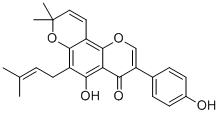Home
Products
Osajin



| Product Name | Osajin |
| Price: | Inquiry |
| Catalog No.: | CN04963 |
| CAS No.: | 482-53-1 |
| Molecular Formula: | C25H24O5 |
| Molecular Weight: | 404.5 g/mol |
| Purity: | >=98% |
| Type of Compound: | Flavonoids |
| Physical Desc.: | Yellow powder |
| Source: | The herbs of Derris robusta |
| Solvent: | Chloroform, Dichloromethane, Ethyl Acetate, DMSO, Acetone, etc. |
| SMILES: |
| Contact us | |
|---|---|
| First Name: | |
| Last Name: | |
| E-mail: | |
| Question: | |
| Description | Osajin is the major bioactive isoflavone present in the fruit of Maclura pomifera with antitumor, antioxidant and anti-inflammatory activities. |
| Target | Apoptosis[1] |
| In Vitro | Osajin significantly decreases the viability of human NPC cells (TW076, CG1 and TW04 cells) in a dose-dependent manner. Osajin induces apoptosis in human NPC cells through multiple apoptotic pathways, including the extrinsic death receptor pathway, and intrinsic pathways relying on mitochondria and endoplasmic reticulum stress[1]. Osajin exhibits growth inhibitory activity on six human cancer cell lines, including kidney, lung, prostate, breast, melanoma and colon cancer cells[2]. |
| In Vivo | Osajin and pomiferin attenuates the myocardial dysfunction provoked by ischemia reperfusion. This is confirmed by an increase in both antioxidant enzyme values and total antioxidant activity. The cardioprotection provided by osajin and pomiferin treatment results from the suppression of oxidative stress and this correlates with improved ventricular function[3]. |
| Cell Assay | NPC cells are seeded in 96-well plates (5000/well) and allowed to adhere for 24 h. The medium is then substituted by a fresh one containing different concentrations (0.01–10 µM) of osajin for another 24 h. For the time-course assay, the incubation times with 5 µM of osajin are 6, 12, 24, 36 and 48 h. After incubation, 10 µl of 5 mg/ml of MTT is added to each well and incubated for 4 h at 37°C. Cell viability is determined using the MTT-based assay[1]. |
| Animal Admin | Rats[1] The Wistar rats are divided into four groups. The first treatment group receives osajin (5 mg/kg/day in 0.5% Avicel); the second treatment group receives pomiferin (5 mg/kg/day in 0.5% Avicel); the placebo group receives only 0.5 Avicel; the last is an untreated control group. Biochemical indicator of oxidative damage-lipid peroxidation product malondialdehyde, antioxidant enzymes-superoxide dismutase, glutathione peroxidase, total antioxidant activity in serum and myocardium are evaluated. The effect of osajin and pomiferin on cardiac function, left ventricular end-diastolic pressure, left ventricular pressure and peak positive +dP/dt ischemia and reperfusion, also is examined[1]. |
| Density | 1.3±0.1 g/cm3 |
| Boiling Point | 632.3±55.0 °C at 760 mmHg |
| Flash Point | 218.7±25.0 °C |
| Exact Mass | 404.162384 |
| PSA | 79.90000 |
| LogP | 7.62 |
| Vapour Pressure | 0.0±1.9 mmHg at 25°C |
| Storage condition | ?20°C |